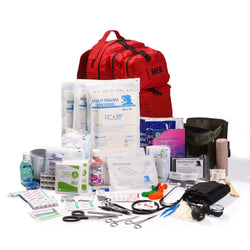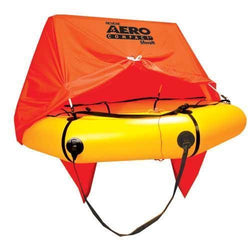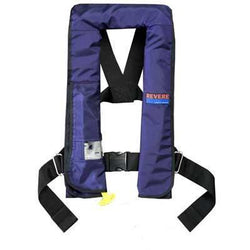 Survival kits have gone mainstream with all the TV shows from “Survivorman “to “Alone,” and even the skin-revealing “Naked and Afraid” weighing in. All the shows come with experts, or sometimes “so-called experts” telling you what is needed in a basic survival kit.
Survival kits have gone mainstream with all the TV shows from “Survivorman “to “Alone,” and even the skin-revealing “Naked and Afraid” weighing in. All the shows come with experts, or sometimes “so-called experts” telling you what is needed in a basic survival kit.
So, whose advice is the best to trust when you’re a pilot planning the minimum survival gear to keep on your plane?
To find out, we consulted Mark – a survivalist with 20+ years of outdoor adventures who has participated in several Search and Rescue (SAR) missions. He shared that the best advice he’s heard for a “basic kit” setup comes from Dave Canterbury.
Dave is most well-known from his stint with the reality TV show “Dual Survival.” Prior to the show, Canterbury spent a long time in the woods as an outdoorsman, going back in time to learn what early Americans and woodsmen used to survive.
After years of adjustments, he narrowed his must-have items down to a list he calls the “10 Cs of Survival.” Dave considers the first five items on the list essential to survival while the second five Cs are geared to “make life a bit easier.” All are difficult to find or replicate in nature.
Keep reading to learn what the 10 C items are and which you may want to add to your current survival kit. If you’re just starting to build out your kit, are looking for a pre-made kit you can add to, or just want to check what may be missing from your existing kit, keep reading.
By the time we’re done, you’ll be familiar with all ten of Dave Canterbury’s must-have item categories and have a high-level idea of why they’re so critical.
 Rule of 3's
Rule of 3's
To understand the importance and rationale for each of the 10 Cs, we first need to cover the priorities in survival. Learning these will help you identify your current needs in any given survival situation.
Another saying taught in survival schools and circles is the “Rule of 3s”. Remember it this way: “You can survive three seconds without the right attitude, three minutes without air, three hours without shelter, three days without water, and three weeks without food”.
Think of the Rule of 3s as a high-level loosely accurate way to remember the relative urgency and priority of each type of need in a survival situation.
3 seconds without the right attitude.
The U.S. Forestry Department used to teach children to “hug a tree” if they wandered away from their family’s campsite and got lost. The purpose of hugging a tree was to get kids to stop moving, calm down, and wait in one spot rather than panicking and running further away from safety.
The 3-second rule is similar. You must have the right attitude, but it is easy to panic and make poor decisions in a survival situation.
To illustrate the life-saving importance of a clear head and right mindset, Mark, the survivalist we spoke to shared a story about an underground fire in a subway or car tunnel. Most people started to walk toward the surface to escape the fire, but an engineer told others to follow him as he moved further down into the dark tunnel.
The people who followed the engineer lived. The others who walked toward the light at the tunnel’s surface died of smoke inhalation. Why? As the engineer correctly understood, the fire created a draft effect that sucked in fresh air from below and created unbreathable air near the surface.
Although certainly a sad set of events, this is an excellent example of having the right attitude, staying calm, and working out the problem in your head instead of jumping at the wrong action or being frozen by inaction.
 3 Minutes Without Air
3 Minutes Without Air
This rule is a rough (and generous estimate) of how long a person can survive without air to breathe. The lack of breathable air could be caused by smoke from a fire, water submersion, or a trauma or medical condition that causes a person to stop breathing.
When deprived of oxygen, the average person will expend their internal oxygen and lose consciousness in far less than the three minutes. If you find yourself in a lack-of-air survival situation, hold onto your right attitude and think your way out of the situation – preferably within a minute or so.
 3 Hours Without Shelter
3 Hours Without Shelter
If you walk away from a plane crash in the middle of winter in the High Sierras with only a t-shirt, you will most likely die within three hours. Like hypothermia in the water, being out in the cold will rob your body’s heat and bring your body’s core temperature down.
Cody Lundin, a well-known primitive skills survival instructor who also starred in “Dual Survival,” wrote a book called “98.6°, How to Keep Your Ass Alive.” In it, Lundin shares that exposure is one of the leading causes of death within 24 hours in the wilderness.
When dumped into a survival situation, it’s tempting to look for water first (once attitude and air are established). This rule of 3 reminds us that emergency shelter is a priority over both water and food.
Once you’ve established a shelter, or if the weather is suitable for both day and night and there are no winds, move on to your next priority.
 3 Days Without Water
3 Days Without Water
Water makes up a large percentage of our bodies, so going without hydration for extended periods can quickly become an emergency. The average person needs about two liters of water a day, but external factors such as climate also play a huge role here.
For example, the hot desert of the Mojave will require different water needs vs. being on the ocean in the Pacific Northwest. Crank up your exertion level or change your location to a hot-dry climate, and your daily water requirement goes up quickly.
 3 Weeks Without Food
3 Weeks Without Food
The last Rule of 3 is “3 Weeks Without Food.” This one is a bit of a stretch, but it follows the principle, which is the main guideline to remember here. The human body “can” go up to three weeks without food. Unfortunately, depending on your overall health and any medications you’re taking, your mileage may vary.
Pro Tip: Speaking of medicine, if you need life-saving medications, carry plenty extra. If you need it to keep you alive, don’t pack just enough for your day trip.
Finally, know this about this last rule and worrying about food: you need water to process food. Eating food if you are not adequately hydrated will only result in you being more dehydrated. Stay away from food until you have a water source.
Yes, your sugar levels will tank, you’ll get horrible headaches, and you won’t even be able to keep your mind on tasks because of your hunger, but if you are like most Americans, you have a little padding. Your body will turn to your fat stores and start to burn fat first than muscle.
Granted, It is not the best, most enjoyable way to test the keto diet, but that is essentially what you are doing. So, if your significant other tells you that you may be carrying extra pounds, tell them, “Nope, I’m a cross-country pilot, and this padding is part of my survival kit. After all, you do want me to come home, right?”
 10 C's of Survival
10 C's of Survival
Earlier, we spoke of the 10Cs of survival and how that is an excellent way to remember what is the essential part of your survival kits. Now we’ll go into detail on what the 10 Cs are and share ideas of how to use them.
Our survivalist, Mark, has always started with the 10Cs, then added about 20 other things as his “basic” kit. He may add more depending on location, climate, weather, and other factors.
For example, Mark says, “I can easily add more in the shelter category alone if I cross mountain ranges at higher elevations. In this case, the shelter components alone would take up about 40% of my pack or kit.”
First 5 C’s of Survival
The first five, most critical of the 10 Cs are:
- Cutting Tool
- Combustion Device
- Cover
- Container
- Cordage
Cutting Tool
Nothing beats a good bush knife, and a Mora Knife is a great inexpensive addition to any survival kit. If a good knife is all you have as a cutting tool, it will also be used for preparing your fire lays, processing wood, cleaning game, building traps, etc.
You can even attach it to the end of a stick and make a spear. The proper knife will have a 90-degree spine on the back and will pull double duty as a flint and steel striker. Run the spine against a ferrocerium rod, and you’ll produce sparks for a fire.
Combustion Device
Your ability to make a fire almost any time in any condition that may be present will be crucial to most survival situations. Practice is a must here—practice in different environments and different situations.
Then when you get good, try processing wood and starting an emergency fire with one hand. This will help if you happen to become injured one day. A ferrocerium rod or “ferro rod” is a robust and everyday fire starter for survival kits.
Making a fire is sometimes taught as the first thing to do (after shelter). The reason is that it is a powerful morale booster. It brings light and warmth and provides a means for cooking and heating food.
Since combustion devices are important, have redundancy and at least 2-3 ways to make fire. These can be stormproof matches, a simple lighter, a ferro rod, and even a pocket magnifier lens. Numerous tender sources are available on the market to help you start fires and keep flames going until your fire lay catches fire.
Cover
The perfect cover is a lightweight, compact, and multi-purpose tarp, dropcloth, or even a heavy-duty plastic trash bag. It can be used as shelter in the form of a windbreak, sleeping bag, or ground covering.
The uses don’t stop there though. Depending on your cover size and shape, you can wear it for sun, rain, and wind protection. It can also be used to catch rain for drinking water or to signal for rescue if it’s reflective or brightly colored.
Container
Nothing beats a single-lined, uncoated metal container in the sticks. Dave Canterbury and other instructors recommend a 32-ounce container. One thing our survivalist learned about 32-ounce containers is that they are the standard for most purification tablets.
Metal containers can heat or boil (purify) water directly over the flame. You can also fill a metal bottle with water in the evening before bed, then heat it next to the fire to make a warm water bottle to keep you warm in your bivvy sack at night.
Cordage
Cordage is very helpful for many things and is very difficult to replicate in the field. Our survivalist likes using standard military 7-strand paracord, also known as 550 cord.
This cordage has seven inner strands that can be pulled out and used for smaller projects like fishing lines and sewing thread. It is rated at 550 pounds. Be careful to get the official 550 cord and not the imitation that does not have the seven strands inside.
 Second 5 C’s of Survival
Second 5 C’s of Survival
The next 5Cs which aren’t technically deemed necessary but are very highly recommended and will make life easier in a survival situation are:
- Cotton Bandana
- Compass
- Candlelight
- Canvas Needle
- Cargo Tape
Cotton Bandana
Dave recommends a 3-foot by 3-foot bandana. It takes little room and is very useful. It can be used as a water filter, a sling, a pressure bandage, a potholder, to pack an open wound, to carry food, to provide first aid, and to make cotton char cloth for easy future fire starting.
Compass
A good quality compass with a built-in mirror will serve for navigation and daytime signaling.
Candlelight
We are not speaking of literal candles here but some kind of flashlight. Our survivalist consultant, Mark, prefers a small rechargeable headlamp that will keep your hands free to perform other tasks.
Canvas Needle(s)
A heavy-duty “sail” needle is super tiny. Use it to repair your gear, stitch up ripped clothing or shoes, suture, remove slivers, and even as a makeshift fishing hook. Mark copied Dave Canterbury here and attached them to the back of his Mora survival knives via a piece of Gorilla Tape.
Cargo Tape
Run an online search for “uses for duct tape,” and you will find page after page. In survival situations, the imagination is the limit. Go for the best brands like Gorilla Tape. Mark rerolls about 15 feet onto a pencil. He says it takes some time but is super compact and still leaves him with a writing tool and some tinder when used.
Final Thoughts on the 10 C's
The 10Cs are a great way to know where to start. A few more things Mark added to his kit include a multi-tool, a small axe, a silky saw, a set of iodine tablets, a small first aid kit or IFAK, and a Combat Applied Tourniquet (CAT) tourniquet.
For an airplane, he would add a Personal Locator Beacon, or “PLB” for short. PLBs are as small as pagers nowadays and direct SAR teams via GPS signal. The ACR 2921 ResQLink 400, the ACR rescueMe PLB1, and the ACR 2922 ResQLink View are good examples of PLBs.
 Flight Outfitters Bush Pilot Survival Kit
Flight Outfitters Bush Pilot Survival Kit
If you do not yet have a pilot survival kit, the Bush Pilot Survival Kit from Flight Outfitters makes a great start. It contains a combustion device (ferro rod) and tinder.
The 550 paracord bracelet has a small compass, whistle, and another ferro rod built in. This covers the rule, “2 is 1 and 1 is none,” meaning if it is so important to have one, then carry two!
Some of the other items in the kit include a small fishing kit, alcohol wipes that double as fire starters, a led flashlight, a signal mirror, first aid supplies, and an emergency blanket (which doubles as a daytime signaling device).
For tools, there is a multi-tool featuring pliers, a knife blade, a wood saw a can and bottle opener, and screwdriver heads. There is also a collapsible blow tube that aids in fire starting.
Pro Tip: The items in this kit were hand-picked by veteran pilots. For more information about aviation survival kits, check out what Alaskan Bush Pilots are required to carry. Also, visit AOPA’s Best Practices for Alaska Aviation Survival for more information regarding gear, best practices, and other available survival education.
It’s Your Turn
Do you carry a survival kit and/or vest onboard? In the comments below, share your must-have items and how you’ve trained to use them. Ever had to break into your survival kit? What went well and what did you learn from the experience?
More Pilot Safety Gear Resources
- Aviation Life Rafts: A Pilots Guide to Survival Equipment
- Pilot’s Guide to Aviation Life Vests (Part 2: Survival Equipment Series)
- Best Portable Oxygen for Pilots [Buyer’s Guide]
Disclaimer:
This article is written with the intent to describe how listed products and materials can be used in survival situations. This article is not a substitute for proper training and hands-on experience. Pilot Mall is not a training site and is not responsible for any harm that may occur through improper use of these products and suggestions.
Did you find this article helpful?
Do you think we missed anything important? Let us know in the comments below!








1 comment
Chris
Bag of dryer lint to use as a fire starter
Signaling mirror
Snack bars
Rain ponchos
Collapsable water bags
Plastic grocery bags
Bug repellant (deet)
Sunscreen
Small fishing kit with lures, line, bobbers and hooks